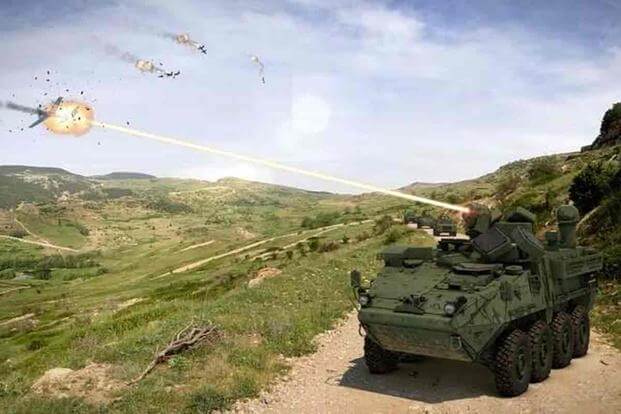Jared Keller

After nearly a decade in development, the Army's primary vehicle-mounted laser weapon is on a collision course with its most fearsome foe yet -- dust.
The service has deployed four Directed Energy Maneuver-Short Range Air Defense, or DE M-SHORAD, prototypes -- Stryker infantry carrier vehicles outfitted with 50-kilowatt laser weapons systems -- to the Middle East for "real world testing" in an overseas operational environment, Army Vice Chief of Staff Gen. James Mingus recently told Breaking Defense.
The four prototypes reportedly arrived in the U.S. Central Command area of operations in early February, with the Army undertaking "initial testing activities" on the path to a future live-fire demonstration, according to Breaking Defense.
While the DE M-SHORAD system has already undergone testing at U.S. military facilities like the White Sands Missile Range in New Mexico, Central Command offers the potential for testing amid real-world challenges like dust storms and other atmospheric phenomena that, according to the Congressional Research Service, could render any directed-energy weapon essentially ineffective.
"Substances in the atmosphere -- particularly water vapor, but also sand, dust, salt particles, smoke, and other air pollution -- absorb and scatter light, and atmospheric turbulence can defocus a laser beam," according to the 2023 CRS report on the Defense Department's directed-energy weapons program.
Shipborne lasers like the 60-kilowatt High Energy Laser with Integrated Optical-dazzler and Surveillance, or HELIOS, weapon system tested aboard Navy destroyers in recent years can "markedly" reduce the impact of atmospheric water vapor on laser performance by emitting radiation only at "sweet spots" in the electromagnetic spectrum, per the CRS report.
But other phenomena such as dust storms don't have as convenient a solution, a problem captured in Mingus' comments to Breaking Defense.
"Our high-energy lasers are so susceptible to weather," Mingus said. "That's why I think this is going to be a great laboratory, because anytime there's a dust storm, anytime there's that kind of thing, it starts to alter the physics of the light particles that actually shoot that beam."
This is not the first time the Army has tested a laser weapon system in an unpredictable operational environment. In August, Maj. Gen. Sean Gainey, director of the service's Joint Counter-Small Unmanned Aircraft Systems Office, revealed that the Army had sent several 10-kilowatt laser systems to the U.S. Central Command, U.S. Africa Command and U.S. Indo-Pacific Command areas of responsibility for "operational assessments."
But the deployment of the 50-kilowatt DE M-SHORAD system represents a major testing milestone for a system that, in development since at least 2015, could offer a major leap forward for the Army's air defense systems at a time when the rising tide of adversary drones necessitates a surge in new capabilities.
Laser weapons have been a pillar of the DoD's revamped short-range air defense strategy since the Russian annexation of Crimea in 2014 and the resulting pivot toward "great power competition" with conventional adversary states like Russia and China.
With near limitless magazines and superior precision to standard kinetic weapons, lasers offer a low-cost way to consistently defeat incoming rockets, artillery and mortar fire, drones and even rotary-wing aircraft. Overall, the DoD spends $1 billion annually developing directed-energy capabilities, according to a 2023 report from the Government Accountability Office.
The need for effective laser weapons has taken on new urgency amid both increased drone and missile attacks on U.S. forces in Iraq and Syria and the rise of Houthi missile attacks on commercial and military vessels in the Red Sea. The latter has led to a call for increased fielding of shipboard laser weapons among Navy commanders whose warships are increasingly forced to fend off incoming airborne threats.
The technological descendent of the Army's Stryker-mounted 5-kilowatt Mobile Experimental High Energy Laser, or MEHEL, and 50-kilowatt Multi-Mission High Energy Laser, or MMHEL -- dubbed "Guardian" -- the DE M-SHORAD laser system became a program of record for the service in 2019. As part of its fiscal 2024 budget request, the Army proposed about $111 million in research and development funding for the laser system and vehicle package, according to service budget documents, down from $197 million the previous year largely due to the completion of a first set of four prototypes.
The Army's 4th Battalion, 60th Air Defense Artillery Regiment, at Fort Sill in Oklahoma, took delivery of the first platoon of four DE M-SHORAD prototypes in September 2023.
"The delivery of DE M-SHORAD prototypes to the 4-60th ADAR represents a transformational milestone in the Army's modernization campaign. It is an achievement that adds what was often thought of as a next-generation capability, now," Col. Steven Gutierrez, DR-MSHORAD program manager, said in a statement at the time. "These high-energy laser systems will be a game-changer on the contemporary battlefield, a critical component of an integrated, layered, and in-depth air missile defense for division and brigade maneuver formations."
The DE M-SHOARD isn't the only laser weapon in the Army's air defense arsenal: The service recently inked a contract with defense giant Lockheed Martin to furnish soldiers with the Valkyrie 300-kilowatt laser weapon which, loaded onto a Heavy Expanded Mobility Tactical Truck, will purportedly provide significant defense against the same family of missile and drone threats that its 50-kilowatt cousin is designed to defeat, as well as other hardened threats like incoming cruise missiles.
After such an investment of time and money in its development, the DE M-SHORAD's nascent laser platoon and the urgent need among commanders downrange are set to intersect during the upcoming operational tests in the Central Command area of responsibility, tests which will likely help define the limitations of the systems that prevent lasers from serving as an "all-weather solution" to incoming drones and missiles in regions such as the Middle East.
"It's a prototype, but we want to experiment in a live environment," Mingus told Breaking Defense. "Is it 100% ready? Is it going to work perfectly? Probably not, but we're going to learn from it."
No comments:
Post a Comment